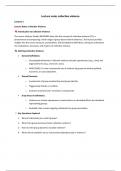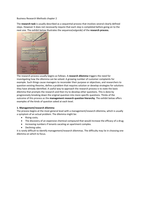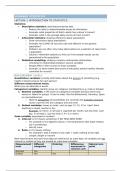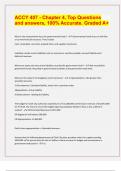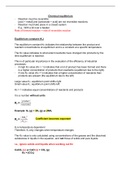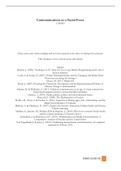Statistics
Course 1.3
Erasmus University Rotterdam
1
, Table of contents
Table of contents .................................................................................................................................... 2
Tutorial 2: Describing at Data ................................................................................................................. 4
Data ..................................................................................................................................................... 4
Terms .............................................................................................................................................. 4
Scales............................................................................................................................................... 4
Distributions ........................................................................................................................................ 4
Graphs ................................................................................................................................................. 5
Categorical variables ....................................................................................................................... 5
Quantitative variables ..................................................................................................................... 6
Time plot ......................................................................................................................................... 7
Numbers.............................................................................................................................................. 7
Center.............................................................................................................................................. 7
Spread ............................................................................................................................................. 8
Linear transformation ..................................................................................................................... 8
Density curves ..................................................................................................................................... 9
Normal distributions ....................................................................................................................... 9
Tutorial 3: Relationships between variables ......................................................................................... 11
Scatterplots ....................................................................................................................................... 11
Correlation ........................................................................................................................................ 12
Two-way tables ................................................................................................................................. 12
Tutorial 4: Producing data. ................................................................................................................... 14
General Concepts .............................................................................................................................. 14
Data Sources ..................................................................................................................................... 14
Experiments ...................................................................................................................................... 15
Terms ............................................................................................................................................ 15
Designs .......................................................................................................................................... 16
Troubles ........................................................................................................................................ 19
Samples ......................................................................................................................................... 19
Reliability and Validity....................................................................................................................... 20
Reliability....................................................................................................................................... 20
Validity: ......................................................................................................................................... 21
The relationship between Reliability and validity:........................................................................ 21
Ethics ................................................................................................................................................. 21
Tutorial 5: Probability ........................................................................................................................... 23
What is probability ............................................................................................................................ 23
Terms ............................................................................................................................................ 23
2
, Symbols ......................................................................................................................................... 23
Rules .............................................................................................................................................. 24
Continuous and Discrete variables ................................................................................................... 25
Discrete ......................................................................................................................................... 25
Continuous .................................................................................................................................... 25
Formulas ........................................................................................................................................... 25
Mean ............................................................................................................................................. 25
Variance ........................................................................................................................................ 26
Standard Deviation ....................................................................................................................... 26
Law of large numbers.................................................................................................................... 26
Tutorial 6: Distributions ........................................................................................................................ 27
Sampling distribution ........................................................................................................................ 27
Pattern of the distribution. ........................................................................................................... 27
Calculations. .................................................................................................................................. 28
Bias and variability. ....................................................................................................................... 28
Tutorial 7: Inferences ............................................................................................................................ 29
Confidence intervals ......................................................................................................................... 29
Meaning ........................................................................................................................................ 29
Formula ......................................................................................................................................... 29
Influences on margin of error ....................................................................................................... 29
Cautions ........................................................................................................................................ 29
Null-hypothesis testing ..................................................................................................................... 30
Terms and symbols ....................................................................................................................... 30
Usage............................................................................................................................................. 31
Things to watch out for. ................................................................................................................ 31
Tutorial 8: Power................................................................................................................................... 33
Power ................................................................................................................................................ 33
Calculation .................................................................................................................................... 33
Influences on power ..................................................................................................................... 34
Possible errors................................................................................................................................... 34
Tutorial 9: T-distribution ....................................................................................................................... 37
One sample t-test.............................................................................................................................. 37
Equivalence testing ....................................................................................................................... 38
Two sample test ................................................................................................................................ 38
Paired test ..................................................................................................................................... 38
Unpaired test ................................................................................................................................ 38
3
, Tutorial 2: Describing at Data
Data
Statistical data is often accompanied by explanations. The data on itself does not mean much.
Before you do a study or read about a study, you ask yourself three questions.
Who? What are the cases, what do they describe, how many are there?
What? What are the variables, what is their definition, what do they measure and how?
Why? What is the purpose of the study?
Terms
Cases: Cases are the objects described by the set of data. Cases can be a lot of things, like subjects,
participants, customers etc. If a study has 200 participants, there are 200 cases.
Variable: Variables are the characteristics of the cases. Different cases can have different values of a
variable.
Label: A variable used to distinguish the cases form each. For example, participant number.
Scales
There are different scales to measure data. The data is first sorted into two categories and both have
two subcategories.
The first two categories are categorical and quantitative.
Categorical variables:
A categorical variable is a variable that has been sorted into different categories or groups.
There are two kinds of categorical variables: nominal and ordinal.
A nominal variable is a variable that sorts the different values into categories. The categories differ,
but there is not a rank order.
An ordinal variable is variable that sorts the values into different categories. These categories do
have a rank order. For example, from completely not agree, to completely agree.
Quantitative variables:
A quantitative variable is a variable that has numerical values that make it possible to do calculations
with it.
An interval variable is a quantitative variable where the distance between two numbers always
means the same, the intervals are equal. The zero point is arbitrary, meaning it can be chosen and it
does not matter where it lies. An example is temperature. 0 degrees Celsius is not 0 on every scale,
but we all mean the same temperature and it does not matter where the 0 lies.
A ratio variable is a variable that is similar to the interval, variable. The only difference is the zero
point. In the case of a ratio variable, the zero point is absence of property, the variable does not exist
for the value 0. For example, the number of questions you get correct. If you have 0 questions
correct, it means you have nothing correct.
Distributions
A graph or numerical summary of data is called a distribution. In a distribution you can see which
values are taken and how often they occur.
4
,To examine a distribution, you need to look at the pattern of the distribution and deviations from
that pattern. To describe the pattern, you look at the shape, center and spread of a distribution. A
value that falls outside the pattern is called an outlier. A big peak in the data is called a mode, if
there is only one peak, the distribution is called unimodal.
Distributions are symmetric when the values smaller or larger than the midpoint are mirror images.
A distribution is right skewed if the right tail is longer and left skewed if the left tail is longer.
Graphs
Each different scale of measurement has their own way to display the data in a graph. Each sort of
variables has their own graphs to display the data.
Categorical variables
In the case of a categorical variable, the graph displays all the categories and the percentage or
counts of the cases that falls into that category. An alternative to use for the percentage is the
proportion.
You can combine the data with small numbers into one category called other, but you need to be
careful with that.
There are two ways to display categorical variables, a bar graph and a pie graph.
Bar graph
5
, Pie graph
Quantitative variables
A quantitative variable can also be displayed two ways. These two methods are very different.
Histogram
A histogram looks like a bar graph but is very different. In a bar graph, the variables are sorted into
categories and the bar fills up till the percentage that category is from the total. In a histogram, the
bars also go up till they reach the frequency they occur at, but the bars are not categories. A
histogram is continuous, meaning that each bar contains the numerical values from x till y, and then
the next bar goes from y till z, etc.
6


